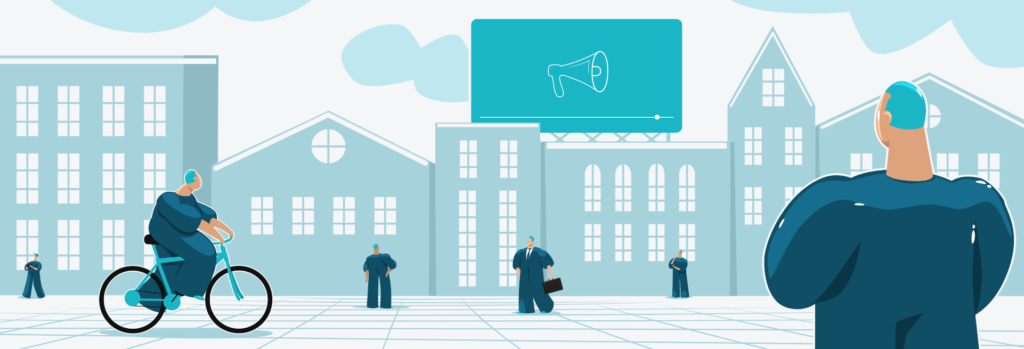What is DOOH – Digital Out-Of-Home Advertising?
Between the famous Times Square in New York and the jostled Shibuya Crossing in Tokyo, can you spot the significant similarity between the two?
If you’re thinking about the stack of digital screen arrays showing advertisements from various brands in front of hundreds of eyeballs, you’re going on the right track.
This article will guide you to understand Digital Out-Of-Home (DOOH) advertising that can be helpful for businesses, advertisers, content creators, and anyone regardless.
So, without further delay, first thing first, ‘What is DOOH Advertising?’
The Basics of DOOH Advertising
DOOH (digital out-of-home) advertising is digital advertising displays located outside of the home, such as in public spaces, transportation hubs, and retail environments.
These displays allow businesses to reach and engage with target audiences through high-visibility, interactive, and personalized advertising campaigns.
With the implementation of AI digital marketing tools, DOOH advertising allows for real-time updates and provides detailed analytics. So advertisers can measure the impact and success of their campaigns.
DOOH Vs. OOH Advertising
Before DOOH advertising spread out massively, OOH advertising was a trendsetter among businesses. In a nutshell, OOH advertising is the traditional version of the two.
Even though they carry the same missions, the primary distinction between them is the medium they use and the features they offer.
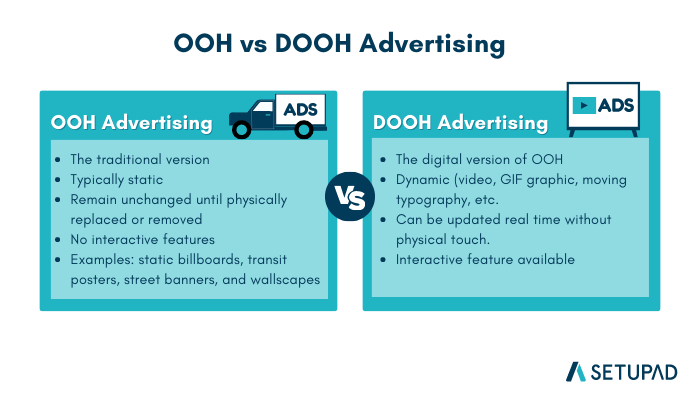
OOH Advertising
As the traditional version, OOH advertisements are typically static. They remain unchanged until physically replaced or removed.
Common examples of OOH advertisements are static billboards, transit posters, street banners, and wallscapes. Audiences can only see them without any interactive features.
DOOH Advertising
Meanwhile, DOOH advertisements use digital screens and displays. They can be interactive and personalized to attract and engage audiences.
Advertisers can perform real-time updates and get detailed analytics on their advertisements’ performance.
DOOH Advertisements Based on Venue Types
Based on the venues, DOOH advertising varies into three types. The location where the advertisement is planted also defines the size of the screens. Take a look below.
Large Format
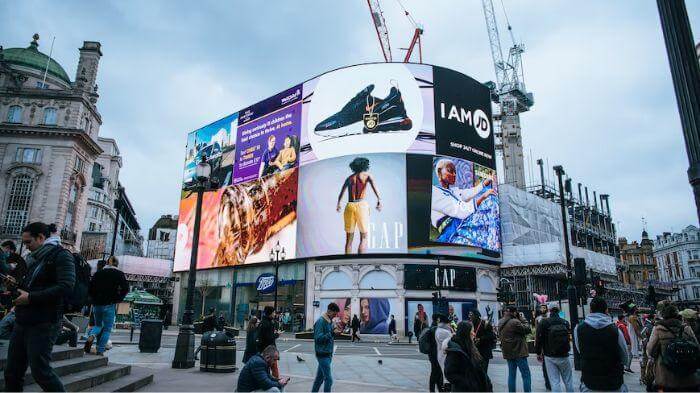
Source: Unsplash
Advertisers using the large format commonly use digital high-impact displays and screens. Common cases are digital advertisements in public spaces such as transportation hubs, retail environments, and high-traffic areas.
The typical examples of large-format DOOH advertisements are the famous Times Square in New York, Piccadilly Circus in London, and Shibuya Crossing in Japan.
Large-format DOOH advertisements are highly visible thanks to large displays that are spottable from a distance. Big screens allow businesses to communicate their messages effectively.
Place-Based Marketing
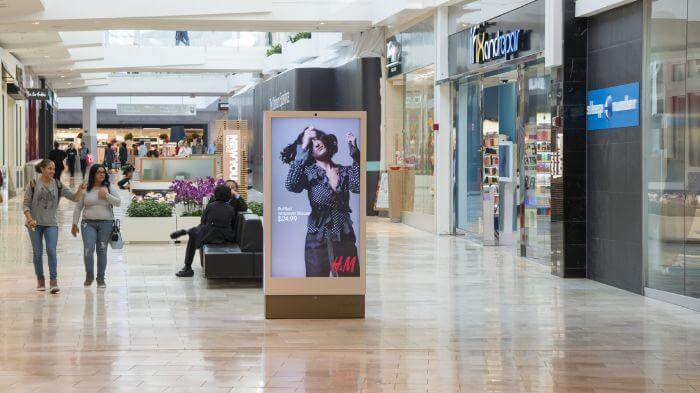
Source: ED
Place-based media focuses on contextually relevant environments, including offices, malls, gas stations, gyms, restaurants, bars, universities, and others.
Place-based screens are ideal for advertisers looking to target a specific audience or take advantage of measurable dwell time. They provide the attention and relevance that is necessary for a successful campaign.
For example, places like gas stations, car shows, and dealerships are great options if you sell cars. Or, if you promote high-protein low calorie bars, gyms are the ideal place to plant your advertisement.
Point-of-Purchase
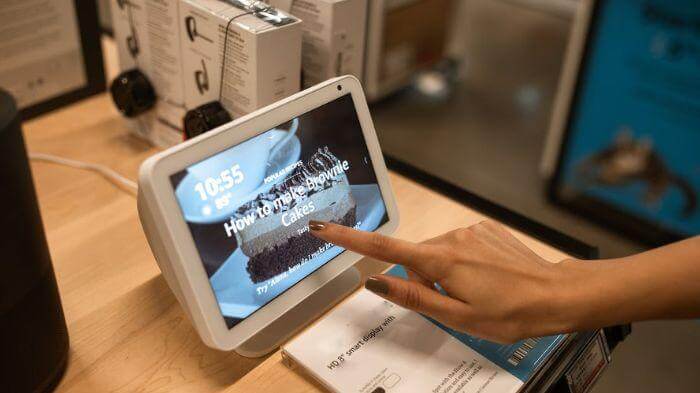
Source: Pexels
Point-of-purchase (POP) DOOH advertising refers to digital advertising displayed at the point of purchase or decision-making. Commonly, you can find them in retail environments, such as stores, supermarkets, and shopping centers to influence people to purchase quickly.
The primary goal is to influence the purchasing behavior of consumers at the moment of decision. Display dynamic and interactive advertisements use features like touchscreens and motion sensors to engage with consumers.
QR codes can be integrated into these dynamic and interactive advertisements to provide an easy way for consumers to access additional information or exclusive offers instantly. Point-of-purchase (POP) DOOH advertising leverages technology to enhance the shopping experience and drive sales.
For example, a brand of snacks could display advertisements for their products near the snack aisle in a supermarket. Or, a skincare brand can use an interactive screen placed on the product shelf to help buyers find the best options for their skin types.
Benefits of Using DOOH Advertising
A study expects the growth of DOOH advertising will continue its upward trajectory. It indicates that ad spending in the DOOH advertising segment will reach US$17.77bn in 2023.
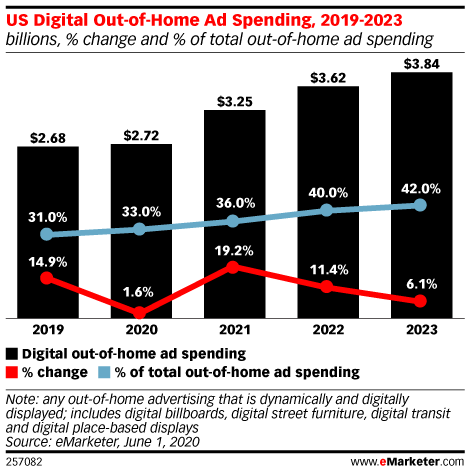
Source: eMarketer
Using DOOH advertising can be quite pricey, especially for smaller businesses and mid-range content creators. However, plenty of its benefits are worth considering. Here are six main benefits of DOOH advertising.
1. Targeted Audience and Settings
Advertisers can design their advertisements to reach a specific group of people. They can specify audiences based on age, gender, income, location, behaviors, and interests.
For example, you can use DOOH advertising to approach gym-goers, fashion enthusiasts, B2B marketers, car enthusiasts, etc. This way, advertisers can expect their advertisements to reach those likely to show interest in their products or services.
Furthermore, targeted settings are no less critical, which refer to the specific locations of the advertisements. The locations can be outdoor, like billboards, bus shelters, and subway stations, or indoor, such as shopping centers, airports, and gyms.
DOOH advertising ensures advertisers reach the right people in the right places and times by considering their target audience and display location.
2. Personalized Content
Personalized content is a key benefit of DOOH advertising. Advertisers can deliver highly relevant and impactful advertisements to their target audience, which can increase the effectiveness of their campaigns.
Advertisers can create content tailored to the target audience’s individual preferences, needs, and behaviors. Moreover, adding interactive features can increase engagement and improve customer service.
3. Highly Visible and Attractive
Commonly, you can find DOOH advertisements in high-traffic areas. It is a marketing strategy to ensure that the advertisements are highly visible to people.
Moreover, DOOH advertisements are typically eye-catching and engaging, with vibrant colors, dynamic animations, and interactive features. Advertisers can get optimum reach and impact, resulting in effective marketing.
4. Highly Flexible and Updatable
The digital nature of DOOH advertisements allows for real-time updates and changes to the content, making it easy to quickly adapt to new information or promotions.
Advertisers can also easily target different audience segments at different times of day. They can ensure the content is relevant and tailored to the target audience at any time.
You can quickly scale and repurpose DOOH advertising for different locations and settings. Therefore it becomes easier to expand the reach of the campaign.
5. Measurable Impact
DOOH advertising offers detailed analytics that enables advertisers to measure the impact and success of their campaigns. The results help them make informed decisions and examine the return on investment (ROI).
Moreover, a combination of hardware and software technologies in DOOH advertising is crucial in collecting vital data. Here is how it works:
- Software technologies: Analytics platforms and cloud-based systems that study and analyze the data collected by the hardware technologies.
They provide real-time insights into the performance of advertisements, including data on audience engagement, reach, and conversion rates. To get one, you need to pay the software engineer’s hiring cost, and that’s all.
- Hardware technologies: Cameras, sensors, and beacons installed in the display screens or the surrounding environment.
They capture audience engagement and interaction data, such as the number of people who view the advertisements, how long they view them, and their demographics.
- Other sources: Social media and third-party data providers.
Those platforms help to gain a more comprehensive understanding of the target audience. The data consolidation from three sources provides a complete picture of the advertisements’ performance.
6. Interactive Capabilities
Interactive DOOH advertisements often incorporate touch screen features. So audiences can interact with the advertisements in real time. They provide a more engaging and memorable experience for audiences than other forms of advertising.
Touch screens enable audiences to access additional information, such as product specifications, prices, and reviews. In the future, we can expect more features implementation like gesture recognition, augmented reality, and virtual reality.
These interactive features also provide advertisers with valuable data on audience behavior. More importantly, they’re effective in increasing conversion rates.
Programmatic DOOH Advertising
Thanks to the advancements of programmatic DOOH advertising, advertisers can establish specific parameters to precisely target their desired audience. This involves uploading creative materials, determining the budget, selecting audience criteria, and outlining campaign prerequisites. Subsequently, the demand-side platform (DSP) utilizes this data to identify the intended audience and deploy the ad at optimal times.
The utilization of programmatic DOOH comes with a range of advantageous features:
- Unified Access Point: A programmatic platform provides a singular entry point for all available DOOH inventory.
- Simplified Planning and Buying: A unified platform encompassing managed service, self-service, or an omnichannel DSP can streamline media planning and digital procurement. This empowers even smaller teams to manage extensive and intricate campaigns adeptly.
- Data-Driven Decision-Making: Each advertisement placement, down to the impression or spot level, is guided by data-driven insights, enabling informed purchasing decisions.
- Holistic Campaign Assessment: Instead of evaluating individual publishers on a case-by-case basis, the impact of campaigns can be assessed collectively.
The Future of DOOH Advertising
Today, advertising has gone digital as it more effectively reaches a broader audience. Other than Search Engine Optimization (SEO), PPC advertising, social media marketing, and programmatic advertising, DOOH advertising is worth spending the budget on.
The future of DOOH advertising is expansive and promising. As programmatic advertising continues to revolutionize how ads are purchased and targeted, DOOH will also benefit from this automated efficiency.
You can expect more innovative and technology-driven features to generate impactful results, analyses, and reports. Here are five improvements we can expect in DOOH advertising.
- Increased integration with technology
- More personalized and interactive experiences
- Expansion into new environments
- Greater focus on sustainability
- Data-driven decision making
Takeaway
DOOH advertising provides a unique opportunity for advertisers and content creators to reach their target audience in a highly visible and engaging manner. That’s why businesses should look forward to it.
The combination of high-quality displays, modern technology, and interactive features makes DOOH advertisements highly effective and provides a unique advertising experience unavailable in other forms of advertising.
As the pandemic ends and the world keeps improving, more people will go on the streets and shop offline. So, utilizing DOOH advertising as your marketing strategy in 2023 can drive a fruitful year!
